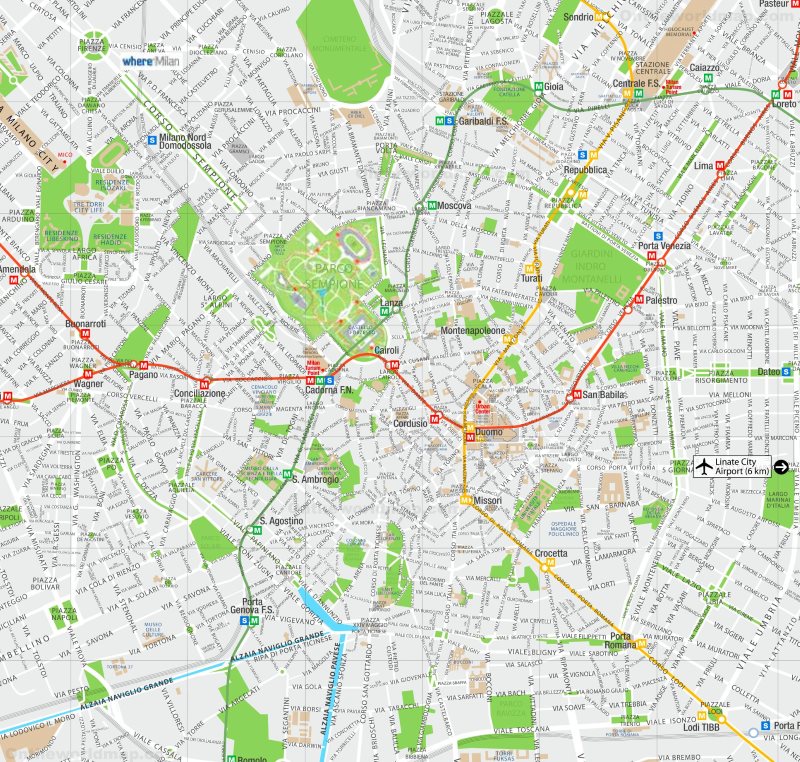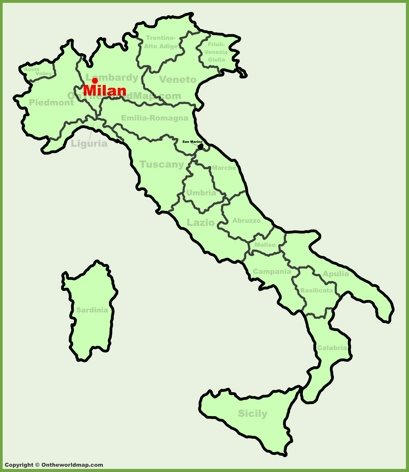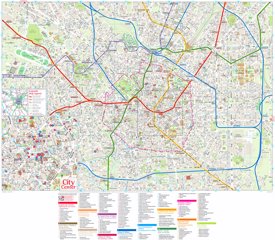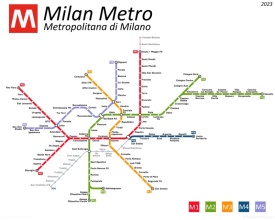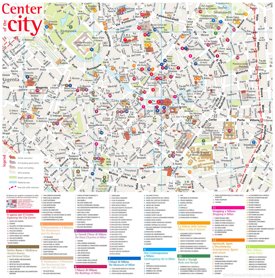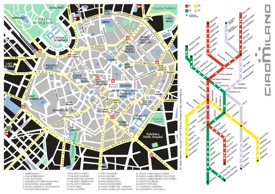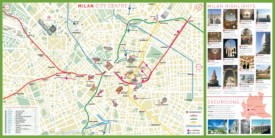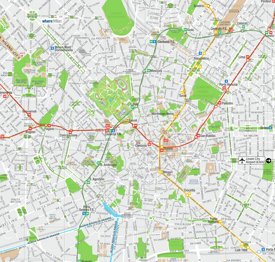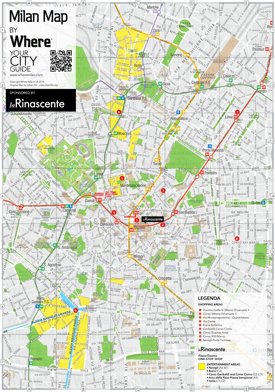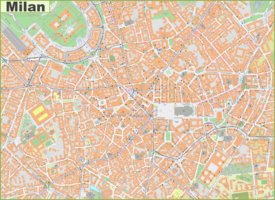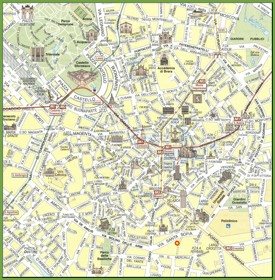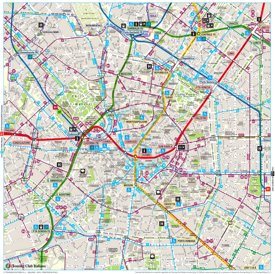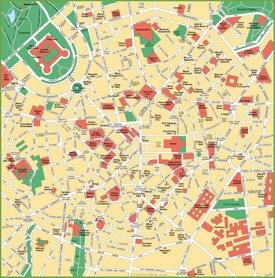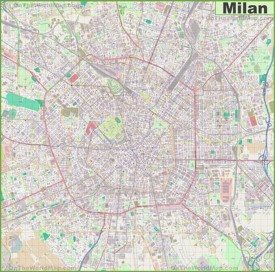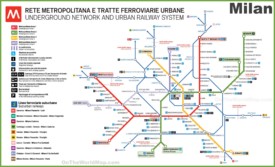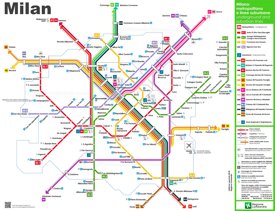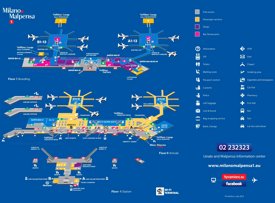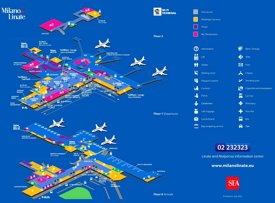Milan Map
Description:
This map shows streets, roads, buildings, metro lines, metro stations, sightseeings and parks in Milan.
Size: 1934x1841px / 1.02 Mb
You may download, print or use the above map for educational, personal and non-commercial purposes. Attribution is required. For any website, blog, scientific research or e-book, you must place a hyperlink (to this page) with an attribution next to the image used.
Online Map of Milan
About Milan
Milan, the main city of northern Italy. Milan is the administrative center of Lombardy, the largest region of Italy, and a territorial unit of the same name, equivalent to a province. Milan is the second largest city in Italy and the center of the country's largest urban agglomeration, and has a reputation as the country's financial, economic and scientific capital and one of the world's fashion capitals. Milan covers an area of approximately 182 square kilometers (70.18 sq mi). As of the latest estimates, Milan has a population of approximately 1.4 million residents. The city is characterized by its cosmopolitan atmosphere and diverse population, attracting people from all over the world for business, education, and tourism.
Milan has a rich history that dates back to ancient times. It was originally founded by the Insubres, a Celtic people, and later became a significant Roman settlement known as Mediolanum. Throughout the Middle Ages and Renaissance, Milan emerged as a major political, economic, and cultural center. The city became part of the Spanish, Austrian, and French empires before joining the Kingdom of Italy in the 19th century.Milan is famous for its architectural diversity, notable landmarks include:
The Milan Cathedral (Duomo di Milano) is an iconic symbol of the city and a masterpiece of Gothic architecture. Construction began in 1386 and took nearly six centuries to complete. It is the largest church in Italy and the third largest in the world. The cathedral is renowned for its intricate facade, spires, and statues, including the golden Madonnina statue at its pinnacle. Visitors can access the rooftop for panoramic views of Milan.


Santa Maria delle Grazie is a UNESCO World Heritage Site, famous for housing Leonardo da Vinci's mural, The Last Supper. Painted between 1495 and 1498, the mural is located in the refectory of the convent adjoining the church. The church itself is a fine example of Renaissance architecture, designed by Donato Bramante.
La Scala (Teatro alla Scala) is one of the world's most prestigious opera houses, inaugurated in 1778. Known for its exceptional acoustics and opulent interior, it has hosted premieres of works by composers such as Verdi and Puccini. The adjacent Museo Teatrale alla Scala offers insights into the history of opera and the theater.


The Sforza Castle (Castello Sforzesco) is a historic fortress built in the 15th century by Francesco Sforza, Duke of Milan. It now houses several museums and art collections, including the Museo d'Arte Antica and the Pinacoteca del Castello Sforzesco. Notable works include Michelangelo's unfinished sculpture, the Rondanini Pietà.


The Galleria Vittorio Emanuele II is a 19th-century shopping arcade, known for its stunning glass-vaulted ceilings and elegant architecture. It connects Piazza del Duomo with Piazza della Scala and is home to luxury brands, cafes, and restaurants. The galleria is one of the world's oldest shopping malls and a popular tourist attraction.


The Pinacoteca di Brera is a leading art gallery in Milan, located in the Palazzo Brera. It houses an extensive collection of Italian Renaissance and Baroque paintings, including works by Raphael, Caravaggio, and Titian. The gallery is part of the larger Brera Academy, an institution dedicated to the arts.
The Navigli Canals district is known for its historic canals, designed by Leonardo da Vinci in the 15th century. Once used for transportation and irrigation, the canals are now a vibrant area with cafes, bars, and art galleries. The Navigli area is particularly lively in the evenings and during the monthly antiques market.
The Monumental Cemetery (Cimitero Monumentale) is an open-air museum, famous for its elaborate tombs and sculptures. Established in 1866, it features works by prominent Italian artists and architects. The cemetery is the final resting place of many notable figures, including Alessandro Manzoni and Arturo Toscanini.
Basilica di Sant'Ambrogio is one of Milan's oldest churches, founded by St. Ambrose in 379-386 AD. It is a prime example of Romanesque architecture and contains important relics and artworks. The church is dedicated to the city's patron saint and features a beautiful atrium and two distinctive bell towers.
Milan is a cultural hub, offering a vibrant arts scene with numerous museums, galleries, and theaters. The city is known for its contributions to music, particularly opera and classical music. Milan's cultural calendar is filled with events and festivals, including the Milan Film Festival and the International Furniture Fair. Milan is Italy's financial powerhouse and one of the world's leading fashion and design capitals. The city hosts the headquarters of numerous multinational corporations, banks, and financial institutions. Milan's economy is diverse, with strengths in finance, fashion, design, technology, and manufacturing. The city is home to the Milan Stock Exchange and hosts major international events such as Milan Fashion Week and the Salone del Mobile furniture fair. Milan is home to several prestigious universities and institutions, including the University of Milan, Bocconi University, and the Polytechnic University of Milan. These institutions are renowned for their academic programs in fields such as business, engineering, and fashion design. Milan has a well-developed transportation network, including an extensive metro system, buses, and trams. The city is a major railway hub, with connections to other Italian cities and international destinations. Milan is served by three airports: Malpensa, Linate, and Orio al Serio, providing domestic and international flights. The Facts:Region: Lombardy.
Province: Metro City of Milan.
Area: 70 sq mi (182 sq km).
Population (2024): 1,370,996[1].
Metropolitan population: ~ 4,500,000.
Main sights: Duomo of Milan, Piazza del Duomo, Sforza Castle, Galleria Vittorio Emanuele II, La Scala, Pinacoteca di Brera, Via Montenapoleone, Milano Centrale, San Carlo al Corso, Royal Palace of Milan, Royal Villa of Milan.
Districts of Milan: Affori, Assiano, Baggio, Barona, Bicocca, Bovisa, Bovisasca, Brera, Bruzzano, Calvairate, Cascina Merlata, Centro Direzionale di Milano, Chiaravalle, Chinatown, Milan, Cimiano, Città Studi, Comasina, Conca del Naviglio, Crescenzago, Dergano, Figino, Forlanini, Gallaratese, Garegnano, Ghisolfa, Giambellino-Lorenteggio, Gorla, Gratosoglio, Greco, Lambrate, Lampugnano, Milano Santa Giulia, Monluè, Morivione, Muggiano, Musocco, Niguarda, Nolo, Nosedo, Ortica, Ponte Lambro, Porta Garibaldi, Porta Genova, Porta Lodovica, Porta Magenta, Porta Monforte, Porta Nuova, Porta Romana, Porta Sempione, Porta Tenaglia, Porta Ticinese, Porta Venezia, Porta Vigentina, Porta Vittoria, Porta Volta, Portello, Prato Centenaro, Precotto, QT8, Quadrilatero della moda, Quartiere Feltre, Quarto Cagnino, Quarto Oggiaro, Quinto Romano, Quintosole, Rogoredo, Ronchetto sul Naviglio, Roserio, San Cristoforo sul Naviglio, San Siro, Milan, Segnano, Taliedo, Trenno, Turro, Vaiano Valle, Vialba, Vigentino, Villapizzone.
References
1. Demografia in cifre. Italian National Institute of Statistics.Maps of Italy
Cities of Italy
Cities of Italy
Regions of Italy

